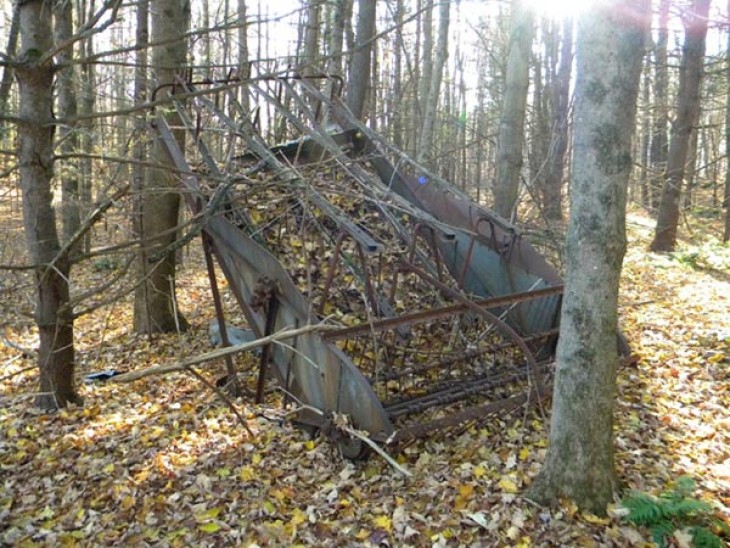Our recent contest picture of a lye barrel prompted readers to submit a number of great historical shots. Here’s one, submitted by Joseph Adams of Rupert, Vermont. OK antique-farm-equipment buffs, what in the woods is this?
Answer
Hay loader
The piece of farm equipment pictured is an old hay loader, or as one reader spelled phonically: a hea-loda. Before the days of hay balers, loose hay was picked up from windrows by this machine and raised to a hay wagon. Farm workers worked on top of the hay as it was loaded onto the wagon and used pitch forks to level and square the load. According to one reader, the workers in the wagon had to “work like hell” to keep up with the driver, but it was easier than the old, old method of throwing the hay into the wagon by hand.
We had many wonderfully detailed responses to this picture. Paul H. speculated that these machines probably had a relatively short life-span historically speaking, as it seemed to be a pretty short step from this labor-saving device to the development of a baler. (Though he did admit to a continued sense of wonder at a modern baler’s knotters – the group of gears and levers that tie a knot while bouncing along a rough, side-hill hay field.)
Many of our readers shared first-hand accounts of using these machines (and more than one needled us for calling it “antique”). David B. has old memories of the machine in use on his grandmother’s farm and a different David B. used one of these up until 10 years ago. Ed Y. remembers boyhood haying bees when local farmers who would go from farm to farm cutting, raking, loading, and hauling hay to the barn. David R. remembers that the faster the driver went, the faster the loaders on the back had to work. “It was not easy on the people on the load, especially if a thunderstorm was approaching,” he wrote. “Been there, done that.” Stan B. echoed these sentiments, saying: “It beat the dickens out of picking loose hay up with a pitchfork, but I was happy when I could afford a baler.”
John C. shared this story about haying salt marshes:
“Where I grew up, Newbury Massachusetts, we hayed the salt marshes using a hay loader. If the marshes were soft, we attached bog-shoes to the horse’s hooves. Made of wood, with iron clamps, and about the size of a big Frisbee, the bog-shoes allowed the horses to pull without sinking in and tearing up the marshy turf. Often, by the time we got to haying the marshes in the autumn, the hay mows in the barn were already be full of field hay (what the farmers called “English hay”), so we stored the salt hay on clusters of sticks stuck upright into the marsh muck. Called “staddles”, the sticks kept the hay up off the marsh turf high enough so that when lunar high tides came and flooded the marshes the hay stacks wouldn’t float away or even get wet feet. Unlike the rectangular hay stacks we built on the wagons and in the barn hay mows, the stacks on staddles were rounded on top, beehive style, so as to shed rain better.
As winter wore on and supplies of English hay stored in the barn mows started to dwindle, farmers would put studs (called “corks”) on the horses’ shoes and go out onto the ice on the marshes with a hay wagon and fill it with hay from the staddles. One staddle’s hay cock usually made a pretty good load of hay. The cows loved the salt marsh hay: it was still green and they loved the salty taste of it.”
Thanks to all of you for sharing your reminiscence and your detailed answers. For a closer look at historical ephemera you might find in the woods, check out the feature that Dave Anderson wrote in our Summer 2008 issue entitled Rust in Peace.
This week’s contest winner was Penny Harris of Jeffersonville, VT! We had almost 100 correct answers!


